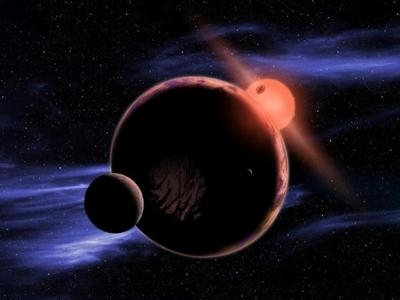Mon, Feb 11, 2013
Research Shows Nearest Planet Suitable For Liquid Water May Be Just 13 Light-Years Away
Using publicly available data from NASA’s Kepler space telescope, astronomers at the Harvard-Smithsonian Center for Astrophysics (CfA) estimate that six percent of red dwarf stars in the galaxy have Earth-size planets in the "habitable zone," the range of distances from a star where the surface temperature of an orbiting planet might be suitable for liquid water.

The majority of the sun's closest stellar neighbors are red dwarfs. Researchers now believe that an Earth-size planet with a moderate temperature may be just 13 light-years away. "We don't know if life could exist on a planet orbiting a red dwarf, but the findings pique my curiosity and leave me wondering if the cosmic cradles of life are more diverse than we humans have imagined," said Natalie Batalha, Kepler mission scientist, NASA's Ames Research Center in Moffett Field, CA.
The research team analyzed 95 planet candidates in the Kepler catalog orbiting 64 red dwarf stars. Most of these candidates aren't the right size or temperature to be considered Earth-like, as defined by the size relative to Earth and the distance from the host star. However, three candidates are both temperate and smaller than twice the size of Earth.
Red dwarf stars are smaller, cooler, and fainter than the sun. An average red dwarf is only one-third as large and one-thousandth as bright as the sun. Consequently, the not too hot or not too cold habitable zone would be much closer to a cooler star than it is to the sun. "This close-in habitable zone around cooler stars makes planets more vulnerable to the effects of stellar flares and gravitational interactions, complicating our understanding of their likely habitability,” said Victoria Meadows, professor at the University of Washington and principal investigator with the NASA Astrobiology Institute. "But, if the planets predicted by this study are indeed found very nearby, then it will make it easier for us to make the challenging observations needed to learn more about them, including whether or not they can or do support life."
The three planetary candidates highlighted in this study are Kepler Object of Interest (KOI) 1422.02, which is 90 percent the size of Earth in a 20-day orbit; KOI-2626.01, 1.4 times the size of Earth in a 38-day orbit; and KOI-854.01, 1.7 times the size of Earth in a 56-day orbit. Located between 300 to 600 light-years away, the three candidates orbit stars with temperatures ranging from 3,400 to 3,500 degrees Kelvin. By comparison, the temperature of the sun is nearly 5,800 degrees Kelvin.
(Image provided by NASA shows artist's concept of planet in orbit around a Red Dwarf star)
FMI: www.nasa.gov
More News
DETRESFA (Distress Phrase) The code word used to designate an emergency phase wherein there is reasonable certainty that an aircraft and its occupants are threatened by grave and i>[...]
Aero Linx: The International Association of Missionary Aviation (IAMA) The International Association of Missionary Aviation (IAMA) is comprised of Mission organizations, flight sch>[...]
Also: EP Systems' Battery, Boeing SAF, Repeat TBM 960 Order, Japan Coast Guard H225 Buy Despite nearly 100 complaints totaling millions of dollars of potential fraud, combined with>[...]
Also: Viasat-uAvionix, UL94 Fuel Investigation, AF Materiel Command, NTSB Safety Alert Norges Luftsportforbund chose Aura Aero's little 2-seater in electric trim for their next gli>[...]
Also: Moya Delivery Drone, USMC Drone Pilot, Inversion RAY Reentry Vehicle, RapidFlight UAVOS has recently achieved a significant milestone in public safety and emergency services >[...]
 ANN's Daily Aero-Term (04.26.24): DETRESFA (Distress Phrase)
ANN's Daily Aero-Term (04.26.24): DETRESFA (Distress Phrase) ANN's Daily Aero-Linx (04.26.24)
ANN's Daily Aero-Linx (04.26.24) Airborne 04.22.24: Rotor X Worsens, Airport Fees 4 FNB?, USMC Drone Pilot
Airborne 04.22.24: Rotor X Worsens, Airport Fees 4 FNB?, USMC Drone Pilot Airborne 04.24.24: INTEGRAL E, Elixir USA, M700 RVSM
Airborne 04.24.24: INTEGRAL E, Elixir USA, M700 RVSM Airborne-NextGen 04.23.24: UAVOS UVH 170, magni650 Engine, World eVTOL Directory
Airborne-NextGen 04.23.24: UAVOS UVH 170, magni650 Engine, World eVTOL Directory



